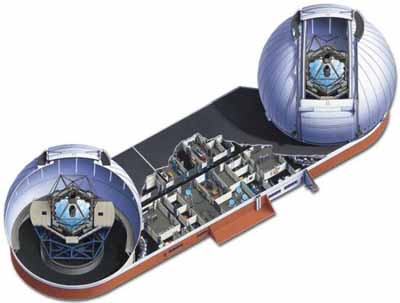
Seeing further and seeing finer detail
In 2005, the largest optical telescopes are the two giant scopes at the Keck observatory in Hawaii. They have primary mirrors, 10 metres in diameter. They are fitted with visible light and infrared detectors.Each of Keck scope gathers four times more light than the 5-meter Hale telescope. They work as a pair* to search for planets round nearby stars, to examine how stars form deep inside dusty gas clouds, and to study how galaxies formed billions of years ago when the universe was young.
* A linked pair of telescopes forms an interferometer. If the signals are precisely aligned, the pair behaves like a collecting dish as large as as the distance separating the two scopes. Interferometry enables us to resolve the universe in finer detail.